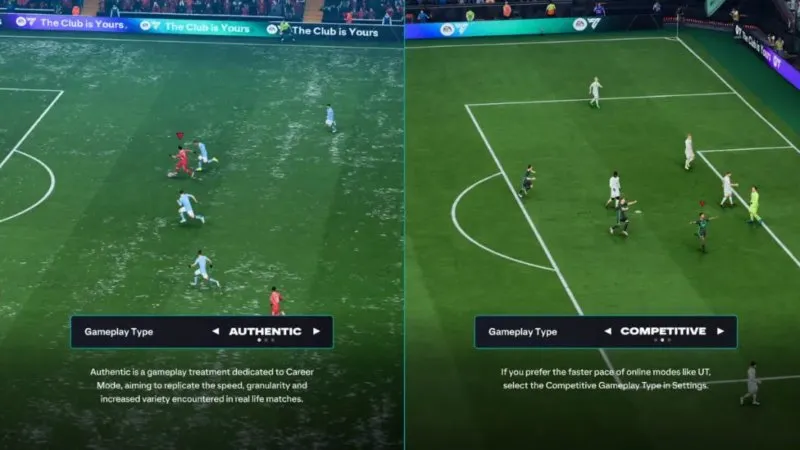
How EA FC 26 Gameplay Shaped with Frostbite Engine
Every year, with the release of the new FC instalment, fans hop on social media platforms to find the answer to a very important question: is this year’s entry different, or is it just updated kits and menus? The truth is that the difference often comes from something most players don’t even think about, the game engine.
For EA FC, that’s the Frostbite engine, and while it doesn’t get the same spotlight as cover stars or Ultimate Team promos, it’s the secret sauce behind how the game actually feels. In FC 26 gameplay, Frostbite is what makes matches smoother, smarter, and more realistic compared to FC 25.
Let’s talk about what Frostbite is, the other games that use it, why it’s so crucial to FC, how it powers FC 26 specifically, and finally, how it stacks up against Konami’s PES and eFootball engines.
What’s a Game Engine, anyway?
If you think of a video game as a movie, then the game engine is the entire film crew in one. It’s the director, camera, sound engineer, and special effects team. A game engine is the entire software framework on which a developer will design and run a game. It takes into account physics and animations, sound and lighting, and even AI.
With no engine in place, dev teams would have to invent the wheel every time it comes to developing a game — think writing ball physics, climate elements, or character animation from zero each time. That’s why Unreal Engine, Unity, and CryEngine are so popular. They provide the fundamental elements at their disposal, and these can be tailored to the sort of game being developed.
For example, Unreal is well-known for amazing appearances and versatility and is used in anything from shooters to RPGs. Unity is loved for its user-friendliness and versatility and is used to power thousands of Indies. CryEngine is excellent at gorgeous, detailed worlds. The best strengths of each of the engines are utilized by devs to guide how their game should feel.
What exactly is Frostbite?

Think of Frostbite like the pitch itself in football. You might not always notice it, but without it, nothing else works. Originally built by DICE for Battlefield, Frostbite handled explosions, collapsing buildings, and massive multiplayer battles. Over time, EA realized this engine was flexible enough to power just about anything — including football.
Frostbite shines because it blends physics, animation, AI, and visuals. The ball reacts like it has a life of its own, spinning, bouncing, and skimming across the turf naturally. Animations flow together so FC players don’t move like robots, while AI routines allow teammates to make smart runs and defenders to position themselves more realistically. On top of all that, it delivers those gorgeous visuals — stadium lighting, pitch textures, and lifelike crowds.
Without Frostbite, FC wouldn’t look or feel anything like it does today.
Which games also use Frostbite?
Frostbite isn’t just about football — it’s EA’s go-to engine across genres. Battlefield is where it started, but since then, it’s powered games like Star Wars Battlefront, Need for Speed, Mass Effect: Andromeda, Dragon Age: Inquisition, and even the Dead Space remake.
It’s wild when you think about it: the same technology that makes a lightsaber glow or a haunted spaceship terrifying also makes a cross-field pass feel natural in FC 26. That flexibility is why EA decided to move its sports titles over to Frostbite years ago — it could be tuned to handle everything from fantasy RPGs to fast-paced football matches.
Why Frostbite is the backbone of EA FC

In football, believability is everything. That’s where Frostbite steps up. It ties together player movement, ball physics, and AI to create matches that feel closer to reality. When you shield the ball, sprint down the wing, or attempt a last-ditch tackle, the engine makes sure the animations, physics, and decisions all connect smoothly.
To put it simply, Frostbite makes sure FC doesn’t just look like football; it actually feels like football. And because the same engine runs across all modes — whether you’re playing Career, Volta, or Ultimate Team — the experience feels consistent.
What Frostbite adds to FC 26 gameplay

This is where the magic really shows. Compared to last year’s game, FC 26 feels tighter, sharper, and more rewarding. That’s because Frostbite has been fine-tuned in some key areas.
Here are a few of the biggest improvements:
- Dribbling is snappier. Players react faster to stick inputs, making feints and turns smoother.
- Shielding feels powerful. Strong players can actually hold off defenders the way they do in real life.
- Tackling is fairer. Collisions are more predictable, so challenges don’t feel like coin flips.
- Goalkeepers are smarter. They position themselves better and make more realistic saves.
Two gameplay styles exist. “Competitive” is fast-paced and responsive for online, while “Authentic” is slower and more realistic for single-player.
All of this comes together to make FC 26 feel like a more polished and flexible game than FC 25.
How FC 26 differs from FC 25

The difference between FC 25 and FC 26 is subtle but important. In FC 25, animations sometimes felt clunky, players didn’t always move naturally, and rebounds or deflections often created chaos. In FC 26, Frostbite smooths out these rough edges. Animations blend more seamlessly, so players look more lifelike. Archetypes stand out more clearly — quick wingers accelerate differently than target men, and those distinctions really change how you build and use your FC squad.
Rebounds and deflections are also toned down, making matches feel less random. And thanks to Frostbite’s improved tools, EA can now release quicker balance patches, so if something feels broken, it won’t take months to fix.
In short, FC 26 feels like the version of FC 25 we always wanted — more polished, more responsive, and more authentic.
Comparing Frostbite with PES and eFootball engines

Let’s look at the age-long rivalry: EA FC vs. Konami’s PES, or eFootball as it is rebranded. PES ran on the Fox Engine, and while it looked gorgeous, it wasn’t very dynamic. Konami then transferred over to Unreal Engine to hopefully give them some added assets, but changed the “feel” of the series.
Frostbite has been carefully optimized to suit the exigencies of football. It offers responsive physics, silky-smooth animation, and the ability to transition quickly in live service updates. PES is typically on the money with football pace and silky-smooth animation, but Frostbite offers FC an edge in steadiness and competitiveness.
Here’s a quick comparison:
| Feature | EA FC (Frostbite) | PES/eFootball (Fox & Unreal) |
| Physics & collisions | Highly responsive and consistent | Organic but sometimes unpredictable |
| Animation blending | Smooth and lifelike transitions | Natural flow, but less engine flexibility |
| AI intelligence | Strong positioning and decision-making | Good, but less consistent across updates |
| Live-service adaptability | Quick updates and balance patches | Updates slower, less fine-tuned |
| Overall “feel” | Fast, responsive, competitive | Smooth, organic, slower-paced |
Both engines have their strengths. PES feels like an elegant Sunday league game, while FC plays like a Champions League clash — fast, tense, and constantly evolving.
Wrapping it up
So there you have it. Frostbite isn’t just some background tech — it’s the real star of the show. It shapes FC 26 gameplay by making dribbling more responsive, shielding more realistic, tackling fairer, and goalkeeping smarter. Compared to FC 25, it’s a clear step forward, and when you look at PES and eFootball, Frostbite’s strengths in responsiveness and live updates become even clearer.
At the end of the day, Frostbite has turned EA FC from just another yearly update into a football experience that feels closer to the real thing. And in FC 26, you’ll notice that evolution every time you step onto the pitch.


